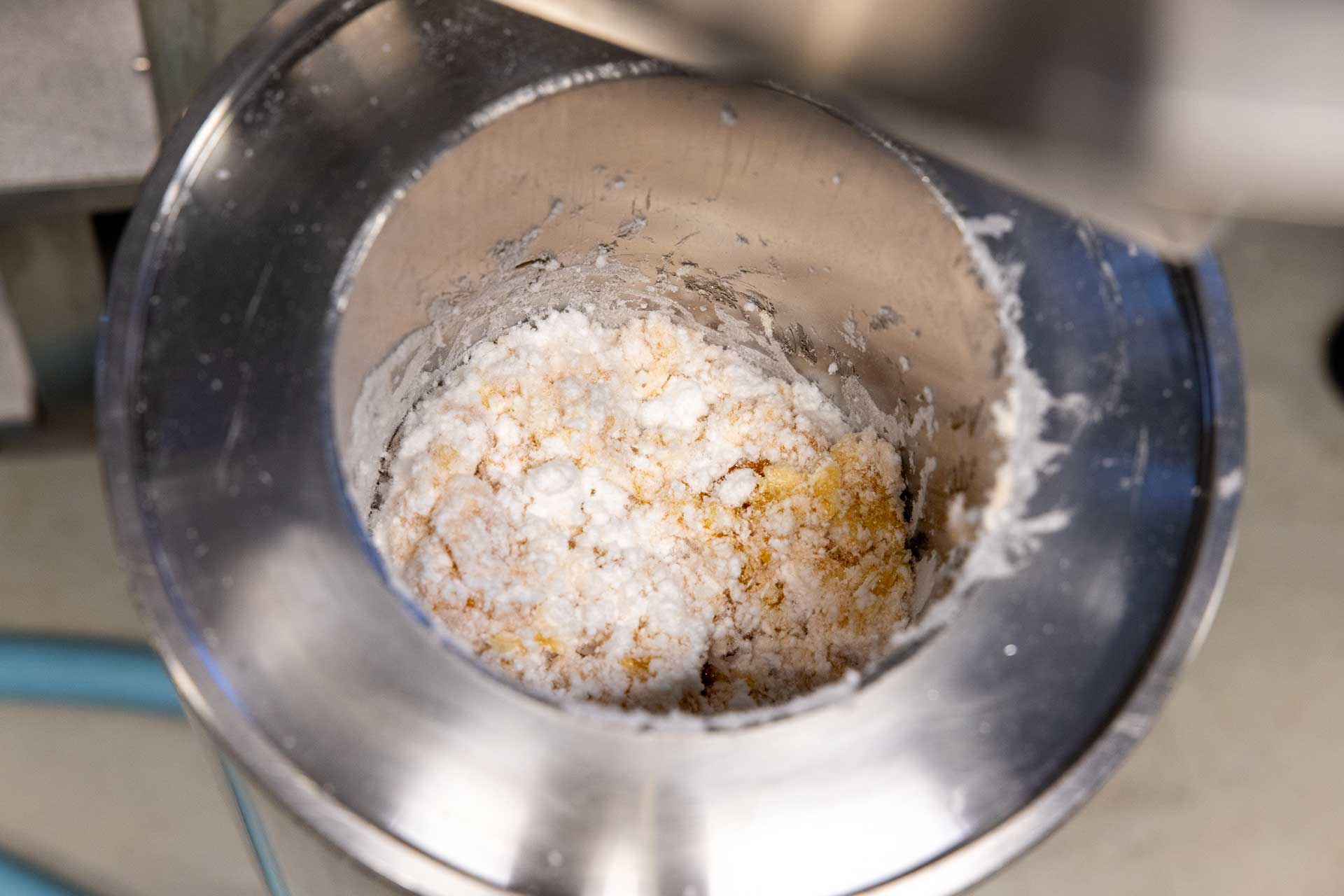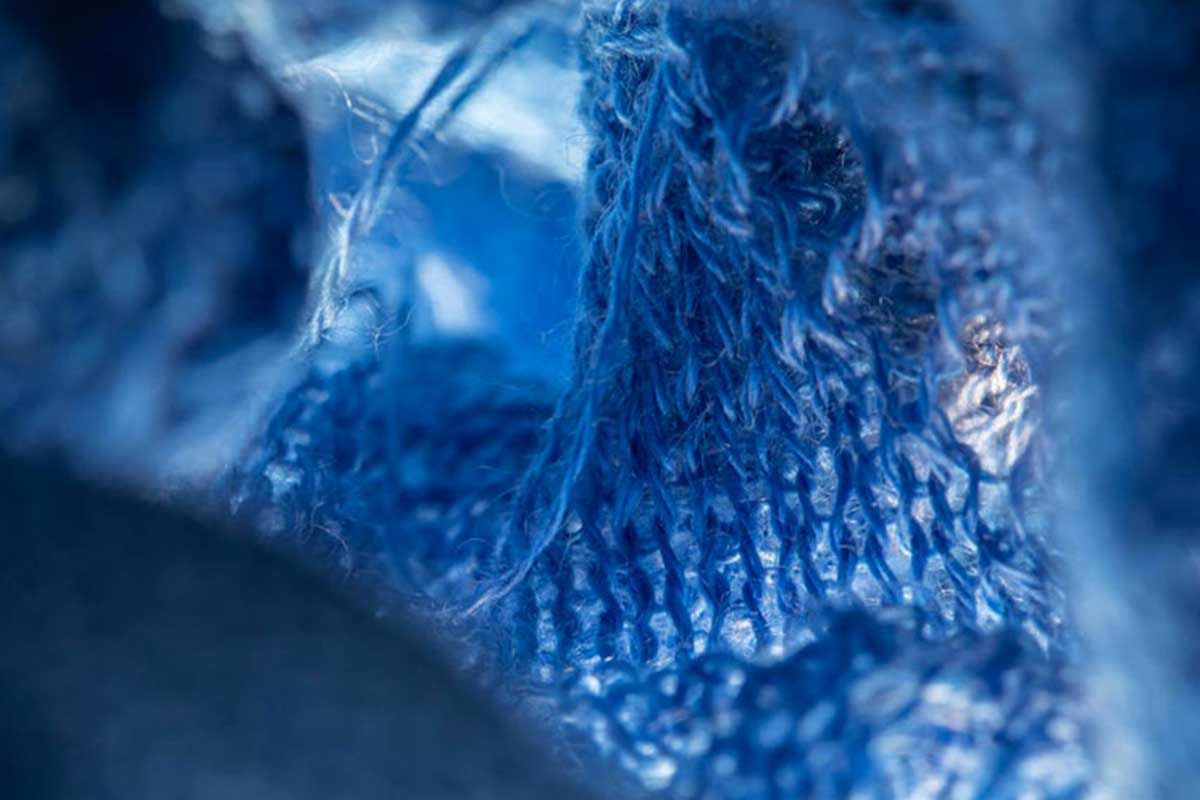Following the Ioncell process, a team of researchers have found a way to dissolve cotton from polyester blends and transform them into new fibers
Upcycling in fashion: Ioncell process
When it comes to approaching upcycling in fashion, there are a number of roads to go down. All of them have their own advantages and disadvantages, each focusing on different sustainable issues to tackle. Simone Haslinger and her team have developed a new strategy to take on waste in the fashion industry using a process called Ioncell. «In this technique the chemicals used aren’t toxic and they can be recycled», explains Haslinger. The basis of the upcycling involves dissolving the cotton from cotton-polyester textile blends and creating new, man-made cellulosic fibers. «For this research, it made sense to use cotton-polyester because of how abundant it is in the market».
Lampoon review: the basis of the Ioncell process
The aim of the process is straightforward: dissolve the cotton to make it into a new fiber, separating it from the polyester to create materials. Once the textile waste is collected, the cotton-polyester material is cut up into small pieces – zippers, buttons etc. are removed beforehand – and passed through a grinder to produce a fine powder. This is then dumped into the ionic liquid, DBNH acetate. It is made from DBN and acetic acid, both of which can be bought from regular supply stores. The ionic liquid is actually one the biggest advantages of this upcycling approach because it is non-toxic. It can also be recycled and reused for a couple more cycles. The cotton-polyester powder is mixed into the ionic liquid for about two hours after which the cotton is dissolved. The whole mixture gets filtered to separate the pure cellulosic solution from the polyester. Given that the solution is dense and viscous-like, it is strained through a long cylinder with tiny holes on the bottom to create spaghetti-like fibers. These strands are then put into a water bath to wash away the solvent. This is where the strands left over are put through a couple of other steps – rolling and cutting them – and finishing once the fiber can be spun into yarn and textile.
Tackling the challenges faced during the process
As mentioned before, each approach has its advantages and disadvantages. When the new man-made cellulosic fibers are put through a water bath to wash them from the ionic liquid, the mixture left behind is then simply water and the DBNH acetate. Once the water evaporates, the ionic liquid can be recycled and then used again «but not that often». The Ioncell research team found that the dissolution strength of DBNH acetate weakens once recycled, which makes it unviable for a continuous process. This led them to switch to another class of ionic liquids that is substantially more stable such as mTBD acetate «which has similar properties to the other one but which can be recycled many more times». Additionally, the usage of the polyester, once it is separated, has not yet been fully determined. «The initial plan was to recover the leftover polyester, melt it and then make them into new polyester fibers. This is something we tested but it turns out that it doesn’t work for multiple reasons».
Haslinger goes on to explain that during the process of making the polyester into fibers, the polymer chains break apart, getting shorter each time; «the shorter they are, the harder it is to make fiber again». Of course, fiber can be made if the leftover polyester undergoes harsher and more intense chemical procedures, but in the case of Haslinger and her team, this was not the intention of their work: «There is no way to make old polyester fibers into new polyester fibers because they are just not strong enough without any stronger chemical reactions. What it can be used for is as a composite material to make tools out of it such as spoons or car parts».
The least sustainable step: the pretreatment
Before the cotton-polyester textiles get turned into a powder for the procedure, there is a pretreatment they first have to go through. Haslinger explained that cotton and cellulose are polymers so they have long chains of molecules. This is only the case in pre-consumer waste – when the clothing has yet to undergo frequent washes and exposure to sunlight. When we talk about post-production waste – clothing which has been worn and washed for some time – the chains of molecules become shorter and less uniformed. To fit the process, these chains need to be as equal in length as possible. This is where the pre-treatment comes in; the least sustainable step in the entire process, according to Haslinger.
Another role which the pretreatment has is based on the coloring of the textiles. «On an industrial scale, if a supplier wants to purchase this new material, they don’t exactly want to have any greenish-brown colors which derive from just mixing all the waste together. They most probably want something which is white which they can re-dye again». The stripping of color is done during the pretreatment in which bleach and water is used, hence making it the least sustainable step. This may make sense and seem like a justifiable solution. Haslinger has developed other approaches such as recycling the color: «Like this you directly sort the waste based on their color and work on a specific color at a time». Again, this may seem like a more sustainable and viable solution but the concept isn’t as simple as just separating the clothes in color categories.
Dyes are made up of different chemicals and all hold different properties so the recycling method can’t be the same for all of them. «Not all of them work in the same way», illustrates Haslinger. «We studied vat dyes which are used a lot in jeans. What we saw is that vat dyes are easy to recycle because they remain well on the fiber. If you were to make a recycling plan for jeans only, it would probably work well because you can control which dyes are used. With reactive dyes, it depends on the type of dye you have». To be able to take advantage of this upcycling strategy, the concept of dyes needs to be taken under consideration; a more efficient and well-rounded process will come from it.
The extent of its sustainable properties
What makes this procedure more sustainable than simply manufacturing cotton fiber in the traditional way? First of all, this uses up already produced clothing, helping in the effort to reduce textile waste. «The longer we are able to maintain the material that we have, the less carbon footprint we produce. If you use waste material which is already there, you keep it in the loop». Secondly, the process doesn’t use toxic chemicals. Contrary to other man-made cellulosic fiber such as viscose, this process is much more sustainable and less harmful to the environment: «it depends on the process you use». Additionally, there are limitations present in the clothing produced today which have an impact on the level of sustainability that they can reach. Clothing, especially in fast-fashion production, is typically made from a variety of fibers: cotton, polyester, acrylic and nylon to name a few. This complicates the recyclability aspect of it.
The basis for upcycling the textiles or recycling the dyes is that they have as many similar properties as possible so that one process can tackle all of them at once. When pieces start having different reactions to the same chemicals or treatments, not everything can be recycled the same way. «For many of the materials which are made from a lot of blends, they need a whole different process. That is why in the future, clothing needs to be made focusing on less components». Haslinger does point out, however, that although garments should start being made from just one material from the button to the zipper, «there will never be a super process which can do everything. The materials are all so chemically different that you cannot simply feed all of the textile into a machine and make a new garment from it. It is more complex than that». This is what makes the recyclability aspect in the fashion industry so limited. People aren’t educated on its complexity: «There is this misconception with fast fashion in which people think that there are so many different recycling processes out there which can take care of the problem so they can continue to buy more clothes».
The unsurprising cost
As with any other recycled or upcycled piece, they do come out as more expensive in the higher value fiber sector. This may not seem surprising but it does demonstrate why the dynamics of the fashion industry need to change; the current priorities are not focused on making the concept of sustainability more dispersed throughout. «The industry needs to get used to the process and optimize it so that it can compete with the prices already in the market».
Regarding its diffusion into commercialization, «the process itself is scalable». If this were to scale up and become an established routine in everyday life, «one of the challenges which would need to be developed is sorting the textile waste. If the clothing labels are cut off, once they are thrown away it’s not as easy to recognize the materials which they’re made from». Haslinger does believe that this could be a viable solution for the fashion industry. As with many other ideas, strategies and techniques which are currently being developed to tackle sustainability issues, they remain capped on a predetermined level as the present state of the industry is simply not equipped with the tools and initiatives to make them more efficient. The dynamics and priorities circulating in the industry need to shift to allow the issue of sustainability to become engraved in all aspects.
Simone Haslinger
Currently a senior R&D Specialist at Reima, a kids activewear brand from Finland. She was a doctoral candidate at Aalto University. Together with her team, she worked with a process called Ioncell to create new fibers out of cotton-polyester blends, textile waste which is currently over-abundant in the fashion industry. Although she is no longer working on this project developed by Aalto University, R&D is still being done by the team and there are plans to expand and commercialize the process.




















